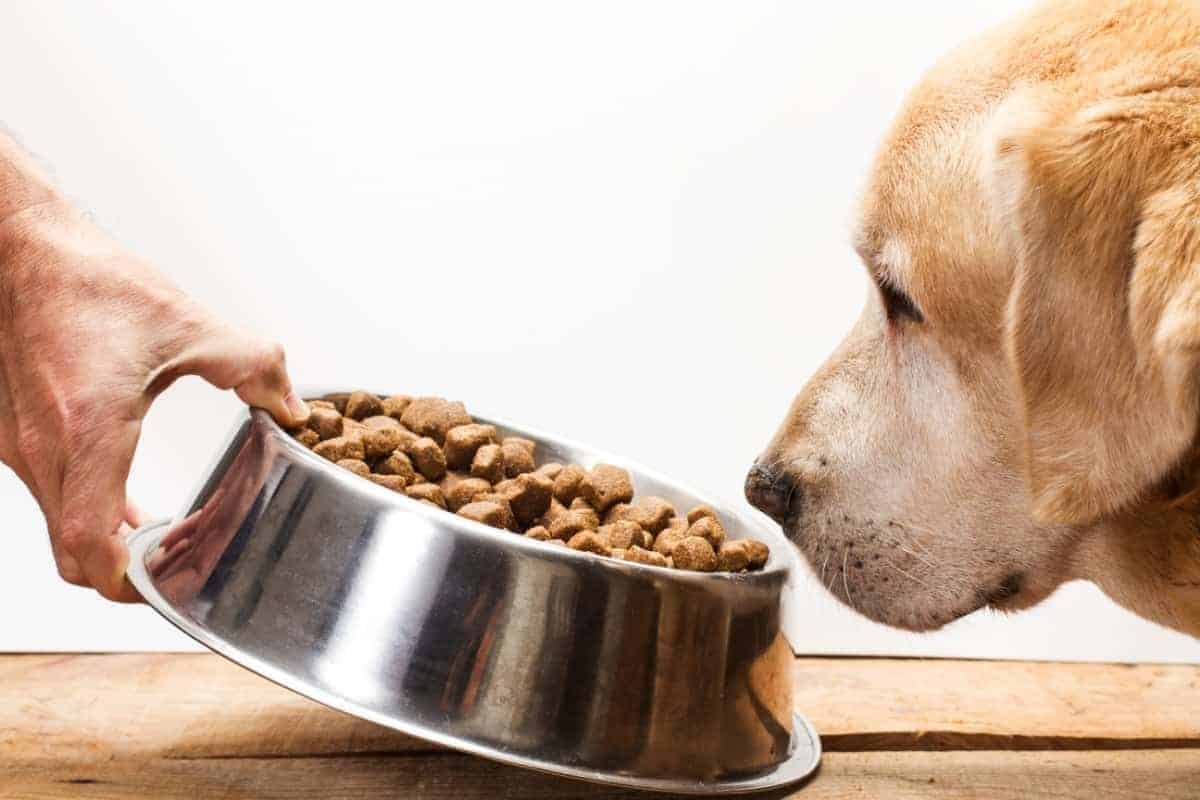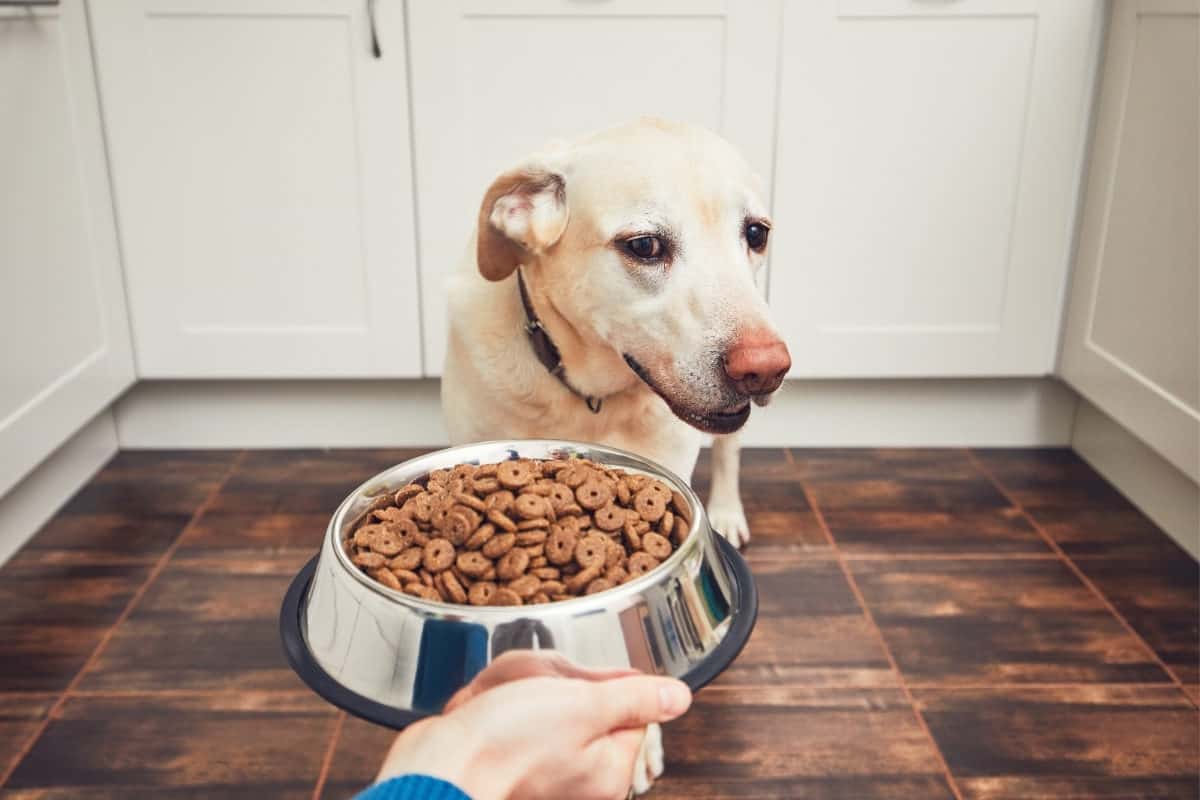Most Labrador Retrievers love their food. However, they can become fussy if you let them! If you’re dealing with a picky eating Lab in your home, you can fix it.
Labradors are generally not fussy eaters as they will gladly eat the same food for years. But, they can become picky due to being fed too many treats or table scraps. Sometimes giving them too much variety in their food can make a fussy Lab, as too much of a good thing can have the opposite effect.
Unfortunately, many owners give in to their dogs’ eating habits, worsening the problem. This article will explore why your Lab may become a picky eater, the health risks associated with fussy eating, and how to get your dog eating again.

So, let’s jump into the world of your fussy eating Lab and discover how to fix it. Let’s get started!
Why is my Lab a Picky Eater?
Labrador Retrievers are known to be obesity-prone. Scientists have identified a deleted gene, POMC, associated with weight and appetite that causes greater food motivation. Nonetheless, some Labs can still become fussy eaters. So, you may be wondering why this is so.
Labradors can become picky eaters due to low-quality food or being fed too many human foods or treats. Occasionally, they can become bored with the same type of food, avoiding their meal. They may have also developed an allergy or food intolerance or could be suffering from anxiety or another health problem.
Labradors are a very affectionate breed. They love to please not only their master but extended family members also. They enjoy obeying you, especially if you reward them with their special treat!
Unfortunately, this special bond doesn’t always prevent Labradors from being fussy eaters, and you may have inadvertently caused their picky eating habits. Here’s a list of reasons why your Labrador might have become a fussy eater:
- Your Lab may be eating poor-quality food and too many table scraps or treats. Your dog may be undernourished if you feed him cheap, low-quality kibble or too much from your plate and too many treats. Dogs aren’t used to digesting carbohydrates, so low-quality, high-carb dog food or large amounts of pasta, bread, or potatoes are unhealthy.
- Your Lab may have developed an allergy or intolerance to his food. This will undoubtedly cause him to become finicky. Your Lab will become super itchy or uncomfortable after eating his kibble, which will prevent him from returning to it when it’s time for his next meal. Excessive itching, frequent ear infections, and tummy troubles are signs of a food allergy.
- Anxiety can prevent your Labrador from eating properly. Anxiety in dogs is more common than you would expect. Unfortunately, it’s not always easy to know if your dog suffers from chronic stress caused by environmental changes like a house move or separation anxiety. In addition to appetite changes, including picky eating, other signs are excessive panting, whining, barking, pacing, or destructive chewing or digging.
- Your Labrador is bored with his food. Dogs experience food differently from humans. They use their powerful noses to differentiate between various flavors rather than their tastebuds. Nonetheless, they may sometimes tire of their food. This is unusual, but it can happen.
- An undiagnosed health condition could be causing your Lab’s fussiness. This would be more concerning if your dog refuses treats or table scraps that he usually loves. Some causes could be stomach issues, pain, or dental problems. Heart disease, kidney failure, or cancer may be to blame in more severe cases.
Risks Associated with Fussy Eating
Sometimes having a picky Labrador can cause other problems, especially if your dog loses his appetite and stops eating properly for weeks. Your dog will inevitably become exhausted, malnourished, and at risk of various health conditions.
Let’s review five of the most common risks associated with fussy eating in Labradors:
- Aggressive or hyperactive behavior. This can occur if your Lab has an inadequate diet. Aggression and hyperactivity have been associated with dog food ingredients, quality, and incorrect ratios. If your dog eats a diet too high in carbohydrates, the blood sugar spikes can make them hyperactive! The study above identified that dietary composition might impact a dog’s behavior under specific circumstances, such as stress.
- Pica (eating non-food items such as dirt, poop, rocks, or grass). Pica in Labs is usually behavioral. However, it can be caused due to malnutrition or other medical problems. Eating non-food items or getting into the garbage due to a lack of nutrients can negatively impact your dog’s health. Non-food items can also cause a severe blockage in his digestive tract. Many poisonous foods can also harm your Lab if he gets into the garbage, such as moldy bread or rotten fruit.
- Depression, anxiety, and lethargy. These are all common symptoms of a dog not getting sufficient nutrition. When your Lab’s being picky, and he won’t eat what you’re giving him, he will eventually feel weak, tired, anxious, and sad. If you notice this problem, you should seek the help of a vet or a pet nutritionist. I found this helpful directory of veterinary nutritionists from the American College of Veterinary Nutrition, where you can get expert advice.
- Diarrhea, constipation, and changes in stools. These are all additional issues that your Lab may encounter if he isn’t getting the vital vitamins and minerals he needs from his food. Many poor-quality dog foods contain stodgy carbs that your dog’s digestive system can’t absorb. Diarrhea and constipation are signs that your Lab’s diet is not suited to him or the quality of the ingredients is poor.
- Poor skin, coat, and poor dental hygiene. Undernourishment can be the cause of all these health issues. Your Labrador’s skin and coat will suffer if he doesn’t get essential fatty acids such as those found in fish and flaxseed oil. Labs also need good-quality dry food instead of eating wet food continuously, which leads to plaque build-up and can cause gum disease.

How to Get a Fussy Labrador to Eat
Breaking a dog’s lousy food habit will be pretty challenging – for you both. However you can do it, but you must break your Labrador’s fussy eating habit before it escalates.
Here are some tips to get your fussy Labrador eating again:
- Don’t feed your dog treats during the habit-breaking process. It might be tempting to reward him for his progress, but treats only worsen it. You’ll condition your Lab only to eat his meal if he knows he’s getting a treat after! Try rewarding him with toys instead.
- Consider the quality of the food. Many pet owners will buy the cheapest, bland food to save money. However, this often lacks nutrition and flavor. If his food doesn’t tempt your Lab, he’ll only eat if he’s starving. Even then, he won’t get the nutrition he needs. Try to choose the best food you can afford.
- Stick to one variety of high-quality complete food. If you repeatedly give your Labrador too much human food, such as chicken or steak, he’ll decline his meals. Instead, don’t bow down to his begging eyes! Also, never remove an uneaten food bowl and replace it with something tastier. This teaches your dog that he’ll get something better by refusing his usual food.
- Stick to a specific feeding schedule. Dogs thrive on routine and prefer a feeding schedule. Free feeding is also not a good option for picky eaters. You can also make a “special place” where your Lab always eats. Keep him away from your mealtimes by feeding him first so he won’t be hungry or show unwanted behavior such as begging or barking for your food.
- Feed your Labrador the correct quantity of food. Along with quality, the amount of food you give your Lab could have something to do with his fussiness, as he may not be hungry. Most reputable brands will have helpful feeding guides or calculators on their websites or packaging to help with this.
- Exercise your Lab to work up an appetite. Labradors need a lot of exercise to keep themselves mentally and physically healthy. Many dog health problems stem from a poor diet or improper exercise, so why not fix them? Exercise your dog to work up an appetite. However, you must give him at least an hour of rest before and after feeding to prevent bloat (GDV), which can be life-threatening.
- Limit mealtimes to 15 minutes. If your Lab knows that he’ll only have a short period to eat, he’s much more likely to get food in his stomach while he can! This stems from dogs’ instincts and not knowing when their next meal will be. Ten minutes is sufficient for him to eat his meal. Read more here, Should I Take My Dog’s Food Away If He Doesn’t Eat It?
- Never try to force him to eat or fuss him. Many pet owners try to tempt their Labrador to eat by waving their bowl in their faces or pointing at it. If your dog refuses his meal after 20 minutes, remove his bowl and only return it a few hours later or at his next mealtime. He’ll soon learn that his food is taken away if he doesn’t eat! For example, on some days, my dog will refuse her breakfast and only eat her dinner. I don’t get too concerned about this as I know she’ll be more hungry the following day and will catch up with her food intake.
- Add a topping to your Lab’s kibble. Some dogs don’t like the consistency of their kibble. Consider adding toppings such as plain yogurt, chicken, or fish to your Lab’s food, or buy different flavors of the same brand. You can also add unsalted chicken or beef broth or warm water to make it into gravy. This increases the aroma and makes your dog’s food more enticing. I like to add warm water to my dog’s food, or I’ll sometimes add a wet food pouch to mix it up for her. Another good tip is to add some raw vegetables to your Lab’s food, such as carrots, broccoli, or peas.
- Transition to an alternative diet, such as raw. A different diet can add distinct flavor and texture and may cure your Labrador’s fussiness. Many dogs do well on a raw diet but always consult your vet first. The extra flavor and difference in texture may just do the trick. To learn more about different diets, check out my top article, Best Diet for Labradors: Nutrition, Types, and More!
- Be aware of food allergies or intolerances. In rare cases, your dog could be allergic to the food they’re eating. The most common symptoms are dry, itchy skin, rashes, and hot spots. This can lead to secondary skin infections, ear infections, and fur loss. Tummy troubles, such as vomiting and diarrhea, can also occur.
- Be persistent and patient. Some dogs can be very dominant and stubborn. If your Labrador is exceptionally fussy, stick to your plan, and have the patience to wait it out! Eventually, your dog will eat his food, taking him one step closer to a regular diet. Dogs are intelligent and can even sense the long-term stress or anxiety you may feel due to their fussiness. This may aggravate the situation causing him also to feel stressed. Stay calm!
- Add a vitamin supplement to his meal. Most supplements have a tasty smell and flavor that your Lab will quickly chew without even knowing that he’s getting added nutrition. It is good to get your Lab eating again, and you won’t have to worry about him becoming malnourished. Always consult your vet before providing any vitamins or supplements, as over-supplementing can be dangerous.
- Consider making a vet appointment. If your Labrador refuses food for two days (24 hours for puppies), take him to the vet for a check-up. Although it’s usually just a matter of pushing through with a finicky Labrador, there could be a health reason why your dog won’t eat. Be aware of other signs such as lethargy, excessive thirst, vomiting, or diarrhea. Dental problems, such as a broken tooth or gum disease, could also be the cause of your dog not eating correctly.
Check Out This Video On How To Get a Fussy Dog To Eat…
Final Thoughts
Breaking any habit takes, but it will be worth the effort. Now that you’re aware of the risks associated with your Lab’s fussy eating, you can understand why many owners wish to fix the problem.
Here are the main takeaways from the article:
- Don’t give in to your Labrador’s fussiness.
- Always feed high-quality food for better health and longevity. Never underestimate the power of nutrition.
- Stop feeding your leftovers and treats, except when training.
- Stick to specific meal times and develop a good routine.
- Ensure your Labrador is well exercised.
Giving in to your dog’s particular ways can also be counterproductive as it can be more expensive if you constantly throw food away or need to keep visiting the vet! However, following the above suggestions will end your dog’s fussiness soon.





